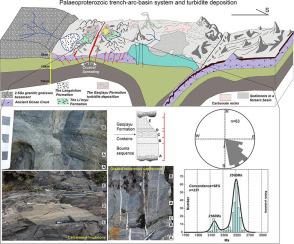当前位置:
X-MOL 学术
›
Precambrian. Res.
›
论文详情
Our official English website, www.x-mol.net, welcomes your feedback! (Note: you will need to create a separate account there.)
Palaeoproterozoic turbidite deposition in the Liaodong Penisula, northeastern North China craton — Constraints from the Gaojiayu Formation of the Liaohe Group
Precambrian Research ( IF 3.8 ) Pub Date : 2021-01-01 , DOI: 10.1016/j.precamres.2020.106008 Zhonghua Tian , Fulai Liu , Zhen Yan , Pinghua Liu , Wang Xu , Lishuang Liu , Fei Wen , Wenjiao Xiao
Precambrian Research ( IF 3.8 ) Pub Date : 2021-01-01 , DOI: 10.1016/j.precamres.2020.106008 Zhonghua Tian , Fulai Liu , Zhen Yan , Pinghua Liu , Wang Xu , Lishuang Liu , Fei Wen , Wenjiao Xiao

|
Abstract The Palaeoproterozoic sedimentary environment is difficult to reconstruct because rocks often experience multiple stages of deformation and metamorphism; however, it is critical to understand the Precambrian evolution of sedimentary basin. In this study, we report two un-metamorphosed sections in the Gaojiayu Formation of the North Liaohe Group, central part of the Jiao-Liao-Ji orogenic belt, eastern North China Craton. Rocks consist of shales, carbonaceous slates, calcareous mudstones and sandstones, marlstones, calcarenites, and brecciated limestones in these sections. Detailed field observations indicate that all kinds of original bedding and syn-depositional structure developed in these rocks. Microscope observations suggest that detritus in rocks predominantly contain feldspars, quartz, and calcites, occasionally with volcanic fragments and pyrites. Palaeocurrent study indicates that the provenance of detritus in rock of these two sections was from NW to SE. Detrital heavy minerals mainly consist of pyrite and hematite, occasionally with barite, which are all from the Li'eryu Formation that contains these minerals in sedimentary layers. The increase of percentages of pyrite in a cross-section indicate that the sedimentary environments transformed from an oxidizing to a reducing depositional environment because the depositional setting became deeper. According to the mafic intrusion dated in this study and regional geochronological data such as the age of underlying volcanic rocks, the depositional age of the Gaojiayu Formation is constrained between 2.17-2.16 Ga and 2.11 Ga. Archaean basement (2.5 Ga) is recognized as the major provenance providing clastic materials for the Gaojiayu Formation; volcaniclastic rocks in the Li'eryu Formation were also a significant source. Accordingly, in this paper we interpret the Gaojiayu Formation as turbiditic sedimentary rocks that were deposited in an arc-related abyssal and semi-abyssal environment, probably in an extensional back-arc basin setting. Palaeoproterozoic turbidite deposition combined with a 2.17 Ga volcanic arc developed in the study area, we conclude that the modern trench-arc-basin system may had already existed in the early Palaeoproterozoic and deeply affected the tectonic evolution of the Jiao-Liao-Ji orogenic belt, northeastern North China Craton.
中文翻译:

华北克拉通东北部辽东半岛古元古代浊积岩沉积——来自辽河群高家峪组的制约
摘要 古元古代沉积环境重建难度大,岩石常经历多期变形变质;然而,了解沉积盆地的前寒武纪演化至关重要。在本研究中,我们报道了华北克拉通东部焦辽冀造山带中部北辽河群高家峪组的两个未变质剖面。这些部分的岩石包括页岩、碳质板岩、钙质泥岩和砂岩、泥灰岩、钙质岩和角砾质石灰岩。详细的野外观察表明,这些岩石中发育了各种原始层理和同沉积结构。显微镜观察表明岩石中的碎屑主要含有长石、石英和方解石,偶尔有火山碎片和黄铁矿。古水流研究表明,这两个剖面岩石中碎屑的物源是从NW到SE。碎屑重矿物主要由黄铁矿和赤铁矿组成,偶有重晶石,均来自沉积层中含有这些矿物的李尔峪组。横截面中黄铁矿百分比的增加表明,由于沉积环境变深,沉积环境由氧化沉积环境转变为还原沉积环境。根据本次研究的基性侵入岩和下伏火山岩年龄等区域地质年代学资料,高家峪组沉积年龄限制在2.17~2.16 Ga和2.11 Ga之间。太古宙基底(2. 5 Ga)是公认的高家峪组碎屑材料的主要物源;里尔峪组火山碎屑岩也是一个重要的来源。因此,在本文中,我们将高家峪组解释为沉积在与弧相关的深海和半深海环境中的浊积沉积岩,可能是在伸展的弧后盆地环境中。研究区古元古代浊积岩沉积结合2.17 Ga火山弧,认为现代海沟-弧-盆体系可能在古元古代早期就已经存在,对胶辽冀造山带的构造演化产生了深刻影响, 华北克拉通东北部。eryu组也是一个重要的来源。因此,在本文中,我们将高家峪组解释为沉积在与弧相关的深海和半深海环境中的浊积沉积岩,可能是在伸展的弧后盆地环境中。研究区古元古代浊积岩沉积结合2.17 Ga火山弧,认为现代海沟-弧-盆体系可能在古元古代早期就已经存在,对胶辽冀造山带的构造演化产生了深刻影响, 华北克拉通东北部。eryu组也是一个重要的来源。因此,在本文中,我们将高家峪组解释为沉积在与弧相关的深海和半深海环境中的浊积沉积岩,可能是在伸展的弧后盆地环境中。研究区古元古代浊积岩沉积结合2.17 Ga火山弧,认为现代海沟-弧-盆体系可能在古元古代早期就已经存在,对胶辽冀造山带的构造演化产生了深刻影响, 华北克拉通东北部。
更新日期:2021-01-01
中文翻译:

华北克拉通东北部辽东半岛古元古代浊积岩沉积——来自辽河群高家峪组的制约
摘要 古元古代沉积环境重建难度大,岩石常经历多期变形变质;然而,了解沉积盆地的前寒武纪演化至关重要。在本研究中,我们报道了华北克拉通东部焦辽冀造山带中部北辽河群高家峪组的两个未变质剖面。这些部分的岩石包括页岩、碳质板岩、钙质泥岩和砂岩、泥灰岩、钙质岩和角砾质石灰岩。详细的野外观察表明,这些岩石中发育了各种原始层理和同沉积结构。显微镜观察表明岩石中的碎屑主要含有长石、石英和方解石,偶尔有火山碎片和黄铁矿。古水流研究表明,这两个剖面岩石中碎屑的物源是从NW到SE。碎屑重矿物主要由黄铁矿和赤铁矿组成,偶有重晶石,均来自沉积层中含有这些矿物的李尔峪组。横截面中黄铁矿百分比的增加表明,由于沉积环境变深,沉积环境由氧化沉积环境转变为还原沉积环境。根据本次研究的基性侵入岩和下伏火山岩年龄等区域地质年代学资料,高家峪组沉积年龄限制在2.17~2.16 Ga和2.11 Ga之间。太古宙基底(2. 5 Ga)是公认的高家峪组碎屑材料的主要物源;里尔峪组火山碎屑岩也是一个重要的来源。因此,在本文中,我们将高家峪组解释为沉积在与弧相关的深海和半深海环境中的浊积沉积岩,可能是在伸展的弧后盆地环境中。研究区古元古代浊积岩沉积结合2.17 Ga火山弧,认为现代海沟-弧-盆体系可能在古元古代早期就已经存在,对胶辽冀造山带的构造演化产生了深刻影响, 华北克拉通东北部。eryu组也是一个重要的来源。因此,在本文中,我们将高家峪组解释为沉积在与弧相关的深海和半深海环境中的浊积沉积岩,可能是在伸展的弧后盆地环境中。研究区古元古代浊积岩沉积结合2.17 Ga火山弧,认为现代海沟-弧-盆体系可能在古元古代早期就已经存在,对胶辽冀造山带的构造演化产生了深刻影响, 华北克拉通东北部。eryu组也是一个重要的来源。因此,在本文中,我们将高家峪组解释为沉积在与弧相关的深海和半深海环境中的浊积沉积岩,可能是在伸展的弧后盆地环境中。研究区古元古代浊积岩沉积结合2.17 Ga火山弧,认为现代海沟-弧-盆体系可能在古元古代早期就已经存在,对胶辽冀造山带的构造演化产生了深刻影响, 华北克拉通东北部。


























 京公网安备 11010802027423号
京公网安备 11010802027423号